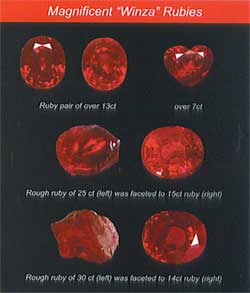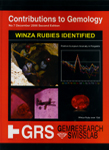| |
| |
WINZA
RUBIES IDENTIFIED
Adolf
Peretti (1,2,3) , Francesca (2), Anong Kanpraphsi (3), Willy
Peter Bieri (2,3), Kathrin Hametner (4) and Detlef Günther
(4), |
| |
| (1) GRS Gemresearch Swisslab
Ltd, Sempacherstr. 1, CH-6003 Lucerne, Switzerland |
| (2) GRS Gemresearch Swisslab
Ltd, Rue du Marche 12, CH-1204 Geneva, Switzerland
|
| (3) GRS (Thailand) CO LTD,
Bangkok, Silom 919/257, 10500 Bangkok, Thailand |
| (4) Laboratory of Inorganic
Chemistry, ETH Hönggerberg, HCI, G113, CH-8093
Zurich, Switzerland |
|
|
INTRODUCTION
A completely new type of ruby material has been discovered
in Tanzania in the area of "Winza" in the
province of Dodoma. The mine is situated SW of the
capital (Dodoma) and can be reached by driving to
the local town of "Mpwapwa" (pronounced
"Papua") and by a further 3 hours of driving
(in the dry season) to the mining site, locally known
as "Winza l\/line".
The rubies are found mostly in primary mines or in
the near-surface alteration zone. Miners from many
different parts of Tanzania rushed to the mining site
when gem quality rubies of excellent colors and exceptional
clarity were discovered in spring 2008. Primitive
methods were used to mine the sites rather than mechanized
large—scaIe mining. A large number
of companies, including gem dealers from Tanzania,
Sri Lanka and Thailand positioned themselves in the
local town of "Mpwapwa", about 100km from
the mining site, where they established local buying
offices. As a consequence, significant numbers of
rubies were excavated and appeared on the world market
in the year 2008. (Fig. Tan01, 04)
Other corundum varieties, such as blue sapphire, pink
sapphire, orangy—pink sapphire ("Padparadscha"-color)
and color-changing sapphire have also been discovered
from the Winza mine. However, only the rubies gained
market importance.
We published a first report on the properties and
identification of the new ruby material from this
mine in Tanzania on our website (Lit. Tan07). The
aim was to support the identification of these rubies
at a critical time, when synthetic or heated materials
could have been mixed with parcels of "Winza"
rubies. In the same period of time other laboratories
also noticed the importance of the materials (Lit
Tan01—Tan11)
particularly during the Basel Fair in April 2008.
Our initial research was based on a first expedition
by one of the directors of GRS (Thailand) to the mine
in March 2008. Extensive fieldwork and sampling was
only possible after a special permission was granted
to GRS by the Tanzanian government on the initiative
of a Tanzanian miner and the support of the Thai and
Sri Lankan gem community in August 2008 (see acknowledgements).
During the onsite investigation took place, the labor
at the mine already sharply
|
|
declined as many miners rushed to a gold finding nearby
and when it became clear that the simple methods used
for mining did not produce any further valuable ruby
findings. A new phase of mining is expected to begin
in early 2009 when more advanced methods are eventually
introduced at "Winza".

Fig.
Tan01 Top: A pair of gem—quality
"Winza" rubies over 13 ct and a heart—shape
"VWn2a" ruby over 7ct.
Row 2 and 3: The two rough on the left were faceted
to the rubies over 10cts that are shown on the right
(tested by GRS in Bangkok in March 2008). These rubies
were partly responsible for initiating the rush to
\/Wnza (Tanzania). These faceted rubies of over 1
Oct possess excellent color (“vibrant"
red), are eye—clean and of high brilliancy and
are spared of thermal enhancement. Because of the
magnilicent quality of these rubies, the l/Wnza ruby
mine became a new
landmark among the most important ruby sources (Fig.
Tan02). For the total number of gem quality rubies
tested by GRS see Fig. Tan04.
|
|
Fig.
TanO2 Geographic map shows the occurrence
of rubies and sapphires with commercial importance.
The new ruby mine of Winza appears in addition to
the ruby mines of Burma, Vietnam, Madagascar Thai/and
and Tajikistan. The localities (black stars) of North-West—Thailand
(Kanchanaburi), Sri Lanka, Kashmir and South Madagascar
(lllakaka) are mostly sapphire occurrences. The occurrence
of Siamese rubies and Kashmir sapphires are nearly
exhausted.
|
|
Fig.
Tan03 The local town of Mpwapwa
(left) and a stop at the local gasoline station for
a wheel change (right). One of the author’s
(AP) plans the last expedition details with an important
Tanzanian miner and sponsor (see acknowledgments).
In the diy season of August 2008, the mine was accessible
within 2-3 hours from this point, which is about 60
miles away. |
|
|
|
|
|








